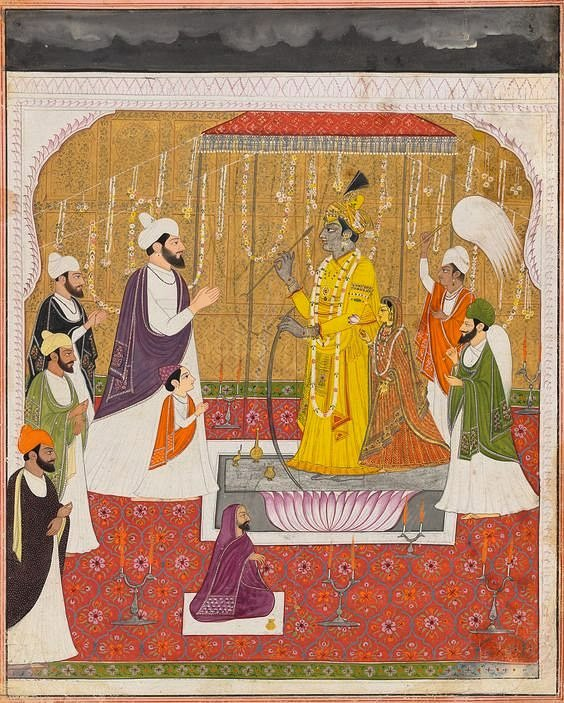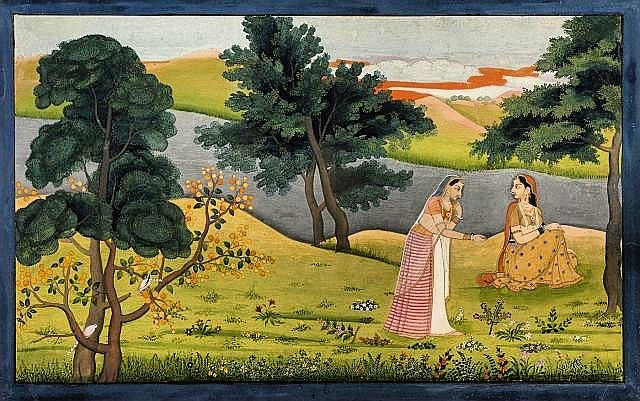India is a land of great rulers, kings, and emperors who have left an indelible mark on the pages of history through their welfare work, bravery, and efficient governance. Among them, the name of Maharaja Sansar Chand Katoch, a skilled and brave warrior of Himachal Pradesh, stands out as a shining example of courage, leadership, and cultural patronage.
Early Life and Family Background
Ascension to the Throne and Military Campaigns
Raja Sansar Chand was a young and ambitious ruler of Kangra who ascended to the Gaddi (throne) at the tender age of ten in 1775 AD. His primary goal was to capture the "Kangra fort", which was then under the garrison of 'Saif Ali Khan.' Sansar Chand sought the aid of Jai Singh Kanheya, and in 1781-82 AD, their combined forces laid siege to the stronghold. It was only after settling territories with Jai Singh Kanheya, that in 1787 AD, Sansar Chand gained possession of the Kangra fort and supreme power in the hills.
Raja Sansar Chand dreamt of establishing the old empire of Jalandhar-Trigarta, which his ancestors had once held. However, the rise of Raja Ranjit Singh proved to be a great hurdle for his ambitions, forcing him to divert his attention towards local hill chiefs. Sansar Chand demanded the hill chiefs' surrender to him as the Lord Paramount of all the fertile tracts that had been included in the Imperial 'Zamindari' attached to the fort during the Mughal rule.
In pursuance of this policy, the Chamba chief was required to make over Rihlu, and on his refusal, Chamba was attacked, and the Raja was killed in a battle at Nerti (near Shahpur). The Mandi kingdom was also treated similarly, with the young Raja Ishwari Sen being made captive and retained as a prisoner at Nadaun for twelve years. Other states like Kutlehr were completely annexed. During this time, Sansar Chand made Sujanpur Tira his capital and erected palaces and temples in this place.
Cultural Patronage and Legacy
Apart from his military campaigns, Maharaja Sansar Chand was also known for his patronage of the arts and culture. He was a great art lover and had a keen interest in music, dance, and literature. During his reign, he built many temples and palaces and also established a school of painting in his court, which came to be known as the Kangra School of Painting. The Kangra School of Painting is now recognized as one of the most significant and influential schools of Indian miniature painting.
For this reason, the reign of Maharaja Sansar Chand ji is called the "Golden age of Kangra".
Development of Kangra Style of Painting
The Maharaja had a great affinity for the Kangra style of painting, which originated from the Guler branch of the Katoch dynasty. During his reign, he took the development of Kangra style to new heights, making it the most prominent style of painting in the region. He commissioned over 40,000 Kangra paintings during his reign, which are still admired for their beauty and grace.
Themes of Kangra Paintings
The central theme of Kangra paintings was Lord Krishna and his beloved Radha. The Sansar Chand commissioned paintings from Bhagvata Purana, Gita Govinda, Mahabharata, Baramasa, Satsai (of Behari Lal), and Rasikpriya (of Keshavdas). The most celebrated artists of the Kangra School of Painting were two brothers, Manaku and Nainsukh, both of whom achieved greatness during this period.
READ IN DETAIL ABOUT : KANGRA PAINTINGS
The Maharaja's love for art and culture was evident in the annual Holi festival held at Sujanpur Tira. The festival sees people from many states visit the ancient town during the festival of colours. It exhibits traditional limelight and provides entertainment through songs, dances, folk dramas, and skirts performed by local artists.
The Downfall of Maharaja Sansar Chand Katoch
Maharaja Sansar Chand Katoch was a renowned ruler of the hills whose fame spread far and wide. His court became the resort of all classes of people in search of pleasure or personal advantage. For 20 years, he ruled as the undisputed monarch of the hills. However, his overwhelming ambition carried him too far, and his fortune turned to misfortune.
In 1803-04 A.D, the Maharaja twice invaded the plains of Hoshiarpur and Bajwarah but was defeated and repulsed by Maharaja Ranjit Singh. Disappointed by his loss, he turned his arms against Kahlur (Bilaspur) and annexed a part of the state lying on the right bank of the Satluj river.
Meanwhile, the Gurkhas of Nepal had developed similar ambitions to Sansar Chand and had extended their dominion over the whole Kumaon, Garhawal, Sirmaur, and other hill states before the end of the 18th century. Upon Sansar Chand's action on Kahlur (Bilaspur), the Raja of Kahlur and other hill states formed a coalition against him and invited Gurkha commander Amar Singh Thapa, who had an army of 40,000 soldiers. The combined armies fought against Sansar Chand's army at Mahal Morian in Hamirpur near Kharwar. Sansar Chand defeated the combined forces and compelled them to retreat on the left banks of the Satluj river.
Defeat and Siege of Kangra Fort
On the advice of General Gulam Muhammad, Sansar Chand tried to affect the economy in the army by replacing the existing ones with Rohillas. However, this proved to be a self-defeating folly on his part. The combined forces again attacked at Mahal Morian in the second battle upon hearing about the weakness in the opponent's army, and they forced a crushing defeat on Sansar Chand in 1806 A.D. The Gurkhas then advanced into the state and, on reaching Nadaun, liberated Ishwari Sen (Raja of Mandi) from the Nadaun jail.
Sansar Chand, along with his family, took shelter in the Kangra fort. The Gurkhas laid siege to the Kangra fort and ruthlessly looted the area between the fort of Kangra and Mahal Morian, virtually destroying the villages. The siege of the fort continued for three years.
Loss of Kangra Fort
Finally, Raja Ranjit Singh, on the request of Sansar Chand, waged war against the Gurkhas and defeated them in 1809 A.D. However, Sansar Chand had to pay a heavy price, losing the Kangra fort and 66 villages to the Sikhs. The entry of the Sikhs into Kangra hills was the end of Raja Sansar Chand's dream of establishing a strong and stable 'Trigat Kingdom.' With this, the glory of Katoches passed away.
The Sikhs maintained their sovereignty over Kangra and Hamirpur until 1846, when they were defeated by the British Army in the first Anglo-Sikh War.
Nevertheless, his legacy lives on in the Kangra School of Painting and the many temples and palaces he built during his reign.








Post a Comment